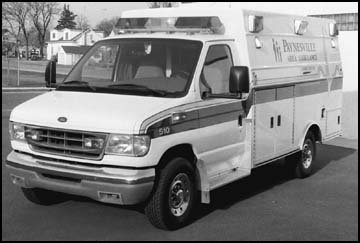 The Paynesville Area Ambulance Corps has made a couple improvements recently. The most dramatic addition was the purchase and arrival of a new ambulance, which brings their fleet up to three rigs.
The Paynesville Area Ambulance Corps has made a couple improvements recently. The most dramatic addition was the purchase and arrival of a new ambulance, which brings their fleet up to three rigs.The corps already has a 1994 heavy duty ambulance that it uses as its primary vehicle. It also has a 1986 Econoline van that was used as back-up. The new ambulance will now be used as their second rig, with the van moving to third.
Steve Stang, corps coordinator, said that just a few weeks ago the corps could have used three ambulances at once. Without the additional ambulance, if one is being used for a transfer and another is called out for an emergency, our base would be empty. In that case, an ambulance would have to come from outside our area.
The new ambulance pictured is a used Braun box and a new Ford chassis. This new rig will be used as their second unit.
Having an extra ambulance locally could mean precious seconds in an emergency, according to Stang. "It's in our interest to make sure that people in our service area are taken care of as best they can," he said.
All three ambulances, Stang said, meet state standards.
"If we only use it one time, it will more than pay for itself," added Larry Bollman, an emergency medical technician (EMT) who served on the committee that organized buying the new ambulance. Bollman said you can't put a price tag on human lives.
An extra ambulance could be very useful in a multiple injury situation, like for car accidents. Stang said Kandiyohi County is talking about dispatching an ambulance for every patient in a car accident. While only part of the corps' area is in Kandiyohi County, it could be called to help for an accident in an adjacent territory. Or it might be asked to cover a territory if their ambulance is needed elsewhere. "They could request everything we've got," said Stang.
Normally, it takes a year to purchase a new ambulance and have it built to certain specifications. Stang listed some of the elements he thought our local corps needed and then a four-person committee--consisting of Bollman, Kevin Odell, Tom Rollings, and Chuck Schmidt--organized the purchase, starting last spring.
They were lucky because they found a used box that was the style they wanted. The 1996 Braun box, called top-of-the-line by Stang, was involved in an accident in the Twin Cities, where its chassis was ruined. This box was put onto a new Ford chassis.
The cost of the used box and new chassis was $78,000. Paynesville Area Health Care System administrator Willie LaCroix said that was a considerable savings to the hospital district. A new model like this could cost at least $100,000.
While smaller than the primary rig, the new ambulance has some special features like electrically-controlled mirrors that can bend both ways. This is important because the corps is now parking four vehicles in a three stall garage and because with 15 drivers in the corps each one wants the mirrors adjusted slightly.
Modifications to the box were mainly due to storage. The corps tries to store supplies in the same compartment in each ambulance, so in an emergency situation it's easy to find the needed supply. "We try to keep it uniform throughout," said Rollings.
"As close to the other trucks as we can," added Stang.
Space is becoming more and more precious in an ambulance because the corps members are taking more and more equipment with them on emergency calls. "It seems like every six months we add another bag," said Stang. Recently, the corps members took a class on starting intravenous fluids, so now they need to carry IV equipment. Plus they have to dispose of the needles and other waste properly.
The heavy duty ambulance is still their primary rig, Stang said, because it has lots of space. In a transfer situation, space is important because the nurse or doctor might bring additional equipment for the ride. In an emergency, this rig could be used as a mobile medical base, while the other rigs could shuttle patients to the hospital.
The new ambulance should be on the road any day now. Since it arrived several weeks ago, it needed to be stocked with supplies and inspected by the state before its first official use.
The ambulance corps also purchased a new cot recently. The new Stryker model was called better designed, more rugged, more maneuverable, and more user friendly by Stang. This top-of-the-line cot cost $4,000. "You still don't see many of these being used," Stang said, "because of the cost."
The cot features larger, molded wheels that provide better traction on rough surfaces and more float on soft ones. Rollings and Bollman said the narrow wheels on other cots can dig into the soft ground and force the cot to be carried.
In addition, the new cot has more head adjustments for patient comfort and for treatment options. It also can reduce to five-feet in length, which increases maneuverability in tight quarters.